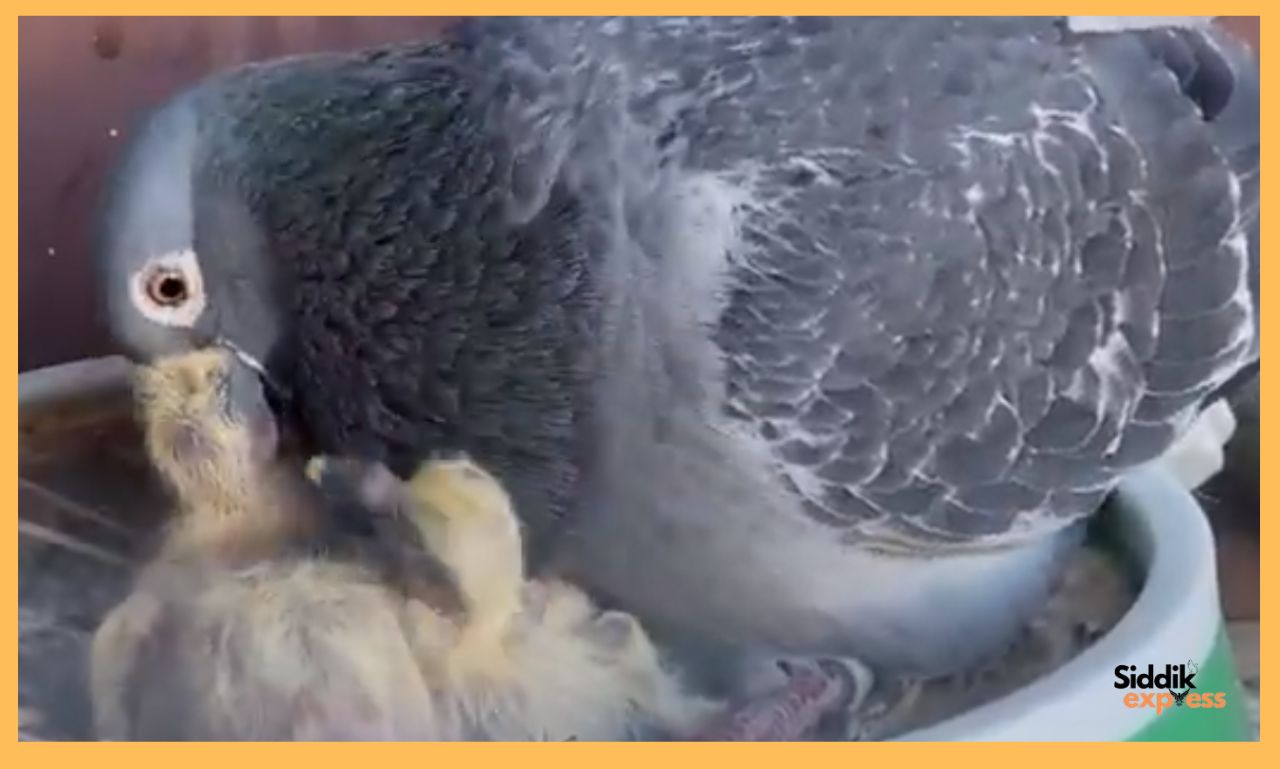Have you ever paused to admire a white pigeon and wondered about its deeper meaning? These serene, graceful creatures have captivated human imagination for centuries, carrying rich symbolic meanings across cultures, religions, and traditions. Often seen as messengers of peace, hope, and spiritual connection, white pigeons transcend their physical presence to embody profound universal ideals.
This article will explore the historical, cultural, and spiritual significance of white pigeons, revealing why they hold such a revered place in human history and modern life. Whether you’re intrigued by their symbolism in art, their role in ceremonies, or their deeper meanings in dreams, this comprehensive guide will unravel the mysteries behind what a white pigeon truly represents.
Table Of Contents
Table of Contents
ToggleThe Historical Significance of White Pigeons
White pigeons have played a pivotal role in human history, often symbolizing divine presence, communication, and unity. Their significance dates back to ancient civilizations, where they were considered sacred creatures, messengers between the earthly and spiritual realms. Let’s take a closer look at their historical roots and their representation across different cultures and religions.
Early Civilizations and White Pigeons
In many ancient societies, pigeons—especially white ones—were seen as symbols of purity, love, and the divine. The Greeks and Romans, for example, associated pigeons with the goddess of love, Aphrodite (Venus in Roman mythology). These birds were believed to carry the essence of love and beauty, often featured in religious rituals and ceremonies aimed at promoting harmony and fertility.
The Egyptians also revered pigeons, associating them with their gods. The bird’s gentle and peaceful nature made it an ideal representation of divine blessings and protection. In many cultures, pigeons were thought to carry prayers to the heavens, making them integral to religious practices.
White Pigeons in Religious Contexts
White pigeons are often linked with spirituality and divine intervention in various religious traditions, particularly in Christianity, Hinduism, and Buddhism.
Biblical References
In Christianity, the white pigeon, commonly known as a dove, has strong biblical associations. One of the most well-known references comes from the story of Noah’s Ark, where a dove returned to Noah with an olive branch, signaling the end of the flood and the restoration of peace on Earth. This moment cemented the dove’s symbolic role as a messenger of peace, renewal, and hope.
In addition, the Holy Spirit is often depicted as a dove in Christian iconography, signifying purity, peace, and divine guidance. This association further emphasizes the white pigeon’s sacred role in Christian theology.
Symbolism in Eastern Religions
In Hinduism and Buddhism, pigeons are also regarded as spiritual beings. They are seen as messengers of the gods, carrying blessings and positive energy. In Hinduism, pigeons are associated with the god of love and devotion, Kama, and are believed to embody the essence of divine love and compassion. Similarly, in Buddhism, pigeons are seen as symbols of peace and harmony, representing the calmness of the mind and the purity of thoughts.
Across these religions, the white pigeon symbolizes not only peace and love but also spiritual enlightenment and the connection between the divine and the mortal world.
The Symbolic Meanings of White Pigeons
White pigeons are rich in symbolism, transcending their physical form to represent powerful universal themes such as peace, love, and renewal. These birds have been admired for their gentle nature, and their symbolic meanings reflect both their elegance and the deeper messages they convey. Let’s explore the most common interpretations of what a white pigeon represents.
Peace and Harmony
One of the most universal and well-known symbols of the white pigeon is peace. Its association with peace can be traced back to ancient times, when it was used in ceremonies to promote harmony and goodwill. The white pigeon’s serene demeanor and soft cooing sound evoke a sense of calm, making it the perfect emblem for peaceful coexistence.
In modern contexts, white pigeons are frequently released during peace rallies, diplomatic summits, and international agreements as a symbol of peace and unity. They are often seen at significant global events aimed at ending conflicts or fostering understanding between nations. The image of a white pigeon soaring freely is a powerful reminder of the importance of peace in the world.
Love and Relationships
White pigeons are also closely tied to love and commitment. Their monogamous nature, with pairs often staying together for life, makes them a fitting symbol of enduring love and loyalty. In weddings, for instance, white pigeons are commonly released to represent the couple’s unity, devotion, and commitment to one another.
Beyond romantic relationships, the white pigeon also represents familial love and friendship. Its gentle nature and graceful movements make it a symbol of kindness, tenderness, and unconditional love—values that are fundamental in any meaningful relationship.
Hope and Renewal
The symbolism of hope and renewal is another significant aspect of the white pigeon’s meaning. Just as the dove in the biblical story of Noah’s Ark brought back an olive branch to signify the end of the flood and the beginning of a new era, white pigeons are often seen as harbingers of a fresh start. Whether after a personal struggle, a challenging period in life, or a collective crisis, the sight of a white pigeon can be seen as a sign of renewal and hope for the future.
This association with renewal is also linked to the bird’s graceful flight, symbolizing freedom and the promise of new beginnings. White pigeons offer a reminder that no matter how difficult the circumstances, there is always hope for a better tomorrow.
The Symbolic Meanings of White Pigeons
White pigeons are more than just beautiful birds—they are steeped in rich symbolism that spans across cultures and traditions. These creatures carry profound meanings, often representing peace, love, hope, and renewal. Their gentle nature and graceful flight have made them powerful symbols in art, literature, and religious practices throughout history. Let’s take a closer look at the various symbolic meanings attributed to white pigeons.
Peace and Harmony
When people think of white pigeons, peace is often the first thing that comes to mind. The white pigeon has been an enduring symbol of peace for centuries, largely due to its calm demeanor and gentle nature. In ancient times, white pigeons were used in rituals and ceremonies designed to promote peace and unity. Their presence in these events helped convey a sense of calm and harmony.
The symbolism of the white pigeon as a peace messenger can be found throughout history, from the release of doves in diplomatic ceremonies to their role in global peace movements. Even today, white pigeons are often released during peace events, protests, and diplomatic negotiations as a powerful symbol of hope and reconciliation.
Love and Relationships
White pigeons are also associated with love, devotion, and fidelity. Known for their strong pair bonds, white pigeons mate for life, which makes them an ideal symbol of enduring love. In weddings, for instance, the release of white pigeons is a tradition meant to symbolize the couple’s commitment to each other and the purity of their love.
This connection to love extends beyond romantic relationships. White pigeons are often seen as symbols of familial love and friendship, reminding us of the importance of nurturing and maintaining our closest bonds. Their peaceful and gentle nature makes them a fitting representation of kindness, compassion, and emotional connection.
Hope and Renewal
Another prominent symbolic meaning of white pigeons is hope and renewal. Their association with new beginnings is deeply rooted in various cultural and religious traditions. In the biblical story of Noah’s Ark, for example, the dove returned with an olive branch, signaling the end of the flood and the restoration of peace. This story has solidified the white pigeon’s role as a harbinger of hope, new life, and fresh starts.
In everyday life, encountering a white pigeon can be seen as a sign that a difficult chapter is coming to a close and that a brighter future is on the horizon. Their graceful flight, often high above the earth, symbolizes freedom, optimism, and the endless possibilities that await us in the future.
Cultural Interpretations of White Pigeons
White pigeons are not only significant in religious and spiritual contexts, but they also carry distinct meanings in various cultural traditions around the world. From Western societies to Eastern philosophies, these birds have been seen as symbols of different virtues and ideals. Let’s explore how white pigeons are interpreted across cultures and what they represent in diverse traditions.
White Pigeons in Western Culture
In Western cultures, the white pigeon is most commonly associated with peace, love, and purity. This symbolism has its roots in Christianity, where the white dove is a representation of the Holy Spirit, peace, and divine presence. For centuries, the image of a white pigeon or dove has been used in religious ceremonies, particularly in weddings, as a symbol of purity, unity, and the sanctity of the relationship.
In modern Western society, the white pigeon is frequently released at public events to convey hope and reconciliation. This practice can be seen in events like peace protests, memorial services, and even during high-profile diplomatic events, where the birds symbolize the desire for global harmony and resolution of conflict. The simple yet powerful gesture of releasing white pigeons embodies the universal wish for peace, making them an enduring cultural symbol in the West.
White Pigeons in Eastern Traditions
In Eastern cultures, white pigeons carry a more spiritual significance. In Hinduism, pigeons are seen as sacred animals, often associated with the god of love and devotion, Kama. The white pigeon, in particular, represents purity, devotion, and the power of love. The peaceful nature of pigeons makes them an ideal symbol of harmony, compassion, and the interconnectedness of all beings.
In Buddhism, white pigeons are seen as symbols of spiritual enlightenment and inner peace. They are often associated with meditation and the idea of transcending worldly desires to achieve a state of tranquility and harmony with the universe. Much like in Western culture, the white pigeon in Eastern philosophies also symbolizes hope and renewal, though it’s more focused on the personal journey toward spiritual awakening.
White Pigeons in Indigenous Cultures
In many indigenous cultures, pigeons—particularly white ones—are viewed as spirit animals or messengers. They are believed to carry messages from the spirit world, providing guidance, protection, and wisdom to those who encounter them. White pigeons are often linked to the idea of balance and harmony in nature, reminding people of their connection to the earth and the importance of living in harmony with nature.
For example, in some Native American traditions, pigeons represent peace and are associated with rituals aimed at healing and restoring balance to communities. The sighting of a white pigeon may be interpreted as a sign that peace is within reach or that a spiritual message is being delivered to the individual or community.
Across these cultures, the white pigeon is seen as a symbol of spiritual growth, protection, and the importance of living in harmony with oneself, others, and nature. Whether as a symbol of divine communication, personal growth, or environmental balance, the white pigeon continues to carry profound meaning in diverse cultural contexts.
White Pigeons in Modern Times
In today’s world, white pigeons continue to be powerful symbols, but their roles have expanded beyond religious and cultural contexts. They are now seen in art, literature, environmental conservation efforts, and even in social and political movements. Let’s explore how the symbolism of white pigeons has evolved in modern times and the different ways they are represented today.
Representations in Art and Literature
White pigeons have long been a popular subject in art and literature, where they are often used to convey themes of peace, hope, and purity. In paintings, sculptures, and poetry, they represent the beauty and fragility of life. Artists like Pablo Picasso, who frequently incorporated doves into his work, used them to symbolize peace and freedom, particularly during times of conflict.
In literature, white pigeons have been used as symbols of renewal or as messengers between different worlds. Whether in poetry, novels, or short stories, the white pigeon’s gentle nature and flight are often metaphors for spiritual transcendence or emotional release.
Role in Ceremonies and Celebrations
White pigeons are commonly used in ceremonies and public celebrations to symbolize unity, love, and peace. The most well-known of these ceremonies is, of course, weddings, where couples release white pigeons as part of the ritual to signify the purity of their union and their shared commitment to each other. The birds serve as a beautiful reminder of the couple’s bond and their hopes for a harmonious future.
Beyond weddings, white pigeons are also seen during memorial services, peace rallies, and other events that mark significant moments in human history. Their release symbolizes a collective desire for peace, healing, and the restoration of balance, making them a powerful addition to public ceremonies that seek to commemorate or heal.
White Pigeons as Messengers
The role of pigeons as messengers dates back thousands of years, and white pigeons are no exception. In ancient times, pigeons were used to carry messages over long distances. Today, while their practical use in communication has been replaced by modern technology, they still carry the symbolic weight of being messengers—whether it’s in the form of peace treaties or as personal symbols in dreams or spiritual practices.
In the modern world, the idea of a pigeon as a messenger persists in a more abstract sense. For example, many people view encounters with white pigeons as signs or omens, often interpreting them as messages from the divine or the universe. Whether through dream interpretation or moments of serendipity, white pigeons are often seen as carrying significant messages about hope, guidance, or change.
White Pigeons in Dreams and Spiritual Practices
White pigeons hold significant meaning in the realm of dreams and spiritual practices. They are often seen as messengers in the dream world, providing insight into a person’s emotional state, spiritual journey, or future. In various spiritual traditions, these birds are believed to carry symbolic meanings that transcend their physical form, offering guidance and clarity to those who encounter them. Let’s explore the role of white pigeons in dreams and spirituality.
Dream Symbolism of White Pigeons
Dreaming of white pigeons can carry multiple interpretations, depending on the context of the dream and the dreamer’s emotional state. In general, these birds are seen as symbols of peace, renewal, and spiritual growth.
- Peace and Resolution: A dream involving white pigeons often signifies the resolution of conflict, both internal and external. If you are going through a period of stress or tension, seeing a white pigeon in a dream can be a sign that peace is on the horizon. It may also suggest that you are about to experience emotional healing or find closure in a situation that has been troubling you.
- Spiritual Awakening: White pigeons in dreams are also associated with spiritual growth and enlightenment. They may appear when you are going through a period of self-discovery or when you are becoming more attuned to your spiritual path. The dream may be a signal to trust your intuition and embrace your spiritual journey.
- Messages from the Divine: In some cases, white pigeons in dreams are considered messengers from the divine or the universe. They may carry a specific message that needs to be understood, such as guidance or reassurance during challenging times. Many people believe that seeing a white pigeon in a dream is a sign of divine protection or support.
White Pigeons in Meditation and Prayer
In various spiritual practices, white pigeons are used as symbols of purity, peace, and connection to the divine. In meditation, they may represent a peaceful state of mind, helping individuals focus on inner stillness and tranquility. The gentle nature of white pigeons aligns with the goals of many meditative practices, which aim to cultivate mindfulness and presence.
In prayer, particularly in traditions that involve the concept of divine guidance, white pigeons are often invoked as symbols of spiritual communication. They are seen as messengers who carry prayers to the heavens, helping to bridge the gap between the human and the divine. For those seeking spiritual clarity or guidance, the presence of a white pigeon in prayer can be seen as a sign of divine support and protection.
Connection with Ancestors and Spirit Guides
In some spiritual traditions, white pigeons are believed to have a unique connection to ancestors or spirit guides. These birds are thought to carry messages from the other side, offering wisdom, comfort, and protection to those who are open to receiving their messages. If you are in search of guidance from ancestors or spirit guides, seeing a white pigeon may be interpreted as a sign that you are being watched over and supported on your spiritual journey.
Whether encountered in dreams, meditation, or prayer, the symbolism of white pigeons as messengers of peace, hope, and spiritual wisdom continues to resonate with people around the world, offering insight and guidance in times of need.
Caring for White Pigeons: A Symbol of Compassion
While white pigeons are often viewed as symbols of peace and love, they are also creatures that require care, attention, and compassion. Whether you’re an animal lover, a bird enthusiast, or someone who has come across an injured pigeon, knowing how to care for these beautiful birds is essential. Let’s explore the practical aspects of caring for white pigeons and how doing so can deepen your connection with them.
Basic Care and Housing Needs
White pigeons, like all birds, need proper care to thrive. If you are considering keeping a white pigeon or have found one in need of help, it’s important to provide an appropriate living environment.
- A Safe, Spacious Cage: If you are caring for a white pigeon in captivity, it is important to provide a clean, safe, and spacious cage. The cage should be large enough for the pigeon to move around comfortably, with perches for resting and space for flying short distances. Make sure the cage is positioned in a quiet, protected area to minimize stress from loud noises or predators.
- Diet and Nutrition: White pigeons are granivores, meaning they primarily eat seeds, grains, and small fruits. A balanced diet is crucial for their health. Commercial pigeon feed can be purchased from pet stores, but you can also supplement their diet with fresh vegetables and fruits like corn, peas, and apples. Make sure fresh water is always available, as hydration is essential.
- Outdoor Flight: If you have the space and resources, providing the pigeon with the opportunity for outdoor flight can be beneficial for its well-being. This is especially important for pigeons that are used to flying freely in the wild. You can create an aviary or an enclosed outdoor space where the pigeon can fly and exercise safely. This helps maintain their physical health and mental stimulation.
Dealing with Injured or Sick Pigeons
If you encounter an injured or sick white pigeon, it’s crucial to act quickly to ensure its survival. Here are some steps to follow when helping an injured pigeon:
- Assess the Injury: If the pigeon is bleeding, has a broken wing, or seems unable to fly, it’s essential to handle the bird gently. Avoid stressing it further and try to keep it calm.
- Seek Immediate Veterinary Help: If you are not experienced in caring for injured birds, it’s best to contact a veterinarian who specializes in birds or wildlife. They can provide professional care and treatment for any injuries or illnesses the pigeon may have.
- Temporary Care: While waiting for veterinary help, you can place the pigeon in a warm, quiet, and comfortable space, away from predators and other stresses. You can offer a small amount of water and some seeds, but avoid feeding too much until a professional can provide further guidance.
Releasing White Pigeons for Peace and Symbolism
In many cultures, the release of white pigeons is an act of peace, symbolizing the release of worries, a wish for a brighter future, or the conclusion of a difficult chapter. If you choose to release a white pigeon as part of a ceremony or personal ritual, it’s essential to ensure the bird is healthy and able to fly. Releasing an injured or unwell pigeon could cause harm to the bird and negate the intended symbolic meaning.
Caring for a white pigeon, whether in need of rehabilitation or as a companion, is an act of kindness that reinforces the deeper messages of peace, love, and harmony that these birds represent. By understanding their needs and providing compassionate care, you can connect more deeply with the symbolic meanings of the white pigeon while ensuring its well being.
The Environmental Importance of White Pigeons
White pigeons, like all birds, play a significant role in the ecosystem. While they are primarily known for their symbolism, they also contribute to environmental balance in various ways. Understanding the ecological importance of pigeons helps to appreciate them not only as symbols of peace but also as vital components of the natural world. Let’s delve into the environmental roles of white pigeons and how they contribute to the health of their habitats.
Seed Dispersal and Plant Growth
One of the most important ecological roles of pigeons, including white pigeons, is their involvement in seed dispersal. As pigeons forage for food, they often consume seeds from various plants. When they excrete waste, the seeds are deposited in different areas, promoting the growth of new plants. This process helps to maintain plant diversity and encourages the growth of vegetation in the areas where pigeons roam.
By spreading seeds, pigeons assist in the regeneration of forests, meadows, and other natural habitats, promoting healthy ecosystems. This role is especially important in areas where plant life is scarce or where deforestation has occurred. Pigeons act as natural gardeners, fostering the growth of plant species that may otherwise struggle to spread on their own.
Food for Predators and the Food Chain
White pigeons are an important part of the food chain, serving as prey for various predators, including birds of prey like falcons and hawks, as well as mammals such as foxes. Their presence in the food chain helps to support the populations of these predators, maintaining a balanced ecosystem.
In addition to this, pigeons themselves are opportunistic feeders, consuming a variety of food sources that contribute to nutrient cycling in their habitats. By feeding on waste grains, fruits, and plants, they help to break down organic matter and recycle nutrients back into the soil, enriching the environment for other organisms.
Indicators of Environmental Health
Birds like pigeons are often considered bioindicators, meaning they can provide valuable information about the health of the environment. Because they are highly sensitive to changes in their surroundings, a decline in pigeon populations can indicate problems in the ecosystem, such as pollution, habitat loss, or climate change.
For instance, a decrease in the number of white pigeons in an area may signal a decline in air or water quality or a disruption in the local food supply. By monitoring pigeon populations, researchers can gain insights into the broader health of ecosystems and take action to mitigate environmental issues before they become more severe.
Pigeons in Urban Environments
While pigeons are often associated with rural or natural settings, they also thrive in urban environments. In cities, white pigeons contribute to the ecosystem in ways that are sometimes overlooked. They help clean up food waste, serve as prey for urban predators, and contribute to the natural balance of the environment.
Urban environments, however, also pose challenges for pigeons. Pollution, lack of natural nesting sites, and human intervention can all affect their health and populations. In this context, the role of conservationists and city planners becomes crucial in ensuring that pigeon populations remain healthy while also maintaining the balance between urban development and the environment.
In conclusion, white pigeons are not only powerful symbols of peace, love, and hope but also important participants in the ecological balance of their habitats. From promoting plant growth through seed dispersal to serving as bioindicators of environmental health, their contributions to the environment are invaluable. By protecting and understanding these birds, we can help maintain the delicate balance of the ecosystems they inhabit.
Conclusion
White pigeons have long captured our imaginations, serving as powerful symbols across cultures and religions. Whether as representations of peace, love, hope, or spiritual renewal, these birds embody a universal message of harmony and connection. From their symbolic roles in Western and Eastern traditions to their environmental importance, white pigeons are far more than just graceful creatures—they are messengers that bridge the gap between humanity and the divine, nature and civilization.
Their presence in art, literature, and ceremonies speaks to our collective yearning for peace and unity. In dreams and spiritual practices, they serve as guides, helping us find clarity and direction in our lives. And as vital contributors to the ecosystems they inhabit, white pigeons remind us of the importance of balance and harmony in the natural world.
Whether you encounter a white pigeon in your daily life, observe one soaring above the skyline, or experience their symbolic meaning in a personal ritual, the messages they carry are timeless and profound. Their gentle nature and strong symbolic ties to peace and love continue to inspire us, urging us to look inward, connect with others, and work toward a more harmonious world.
Ultimately, white pigeons teach us that peace is not only a distant ideal but something we can cultivate within ourselves and in our communities, one graceful flight at a time.
FAQ
White pigeons are released at weddings to symbolize the purity and love between the couple, as well as their hope for a peaceful and harmonious future together. The release of pigeons represents the couple’s commitment to each other and their shared journey ahead.
Are white pigeons considered good luck?
Yes, many cultures believe that encountering a white pigeon brings good luck. It is often seen as a sign of good things to come, offering hope, blessings, and positive energy. The symbolism of a white pigeon in dreams or real life is often interpreted as a sign of peace and positive change.
What does it mean to dream of a white pigeon?
Dreaming of a white pigeon is often interpreted as a sign of peace, spiritual growth, or the resolution of conflict. It can also be a message of guidance from the divine or the universe, offering reassurance or signaling that a positive change is on the way.
How can I care for a white pigeon?
Caring for a white pigeon involves providing a clean, spacious living area, a proper diet of seeds and fresh water, and opportunities for flight and exercise. If you encounter an injured or sick pigeon, it’s important to handle it gently and seek professional veterinary care to ensure its well-being.
What does a white pigeon symbolize?
A white pigeon symbolizes peace, purity, love, and hope. It is often associated with religious and spiritual meanings, representing divine presence, the Holy Spirit, or messages from the universe. In many cultures, it signifies the end of conflict and the beginning of healing or unity.
Why are white pigeons released at weddings?
White pigeons are released at weddings to symbolize the purity and love between the couple, as well as their hope for a peaceful and harmonious future together. The release of pigeons represents the couple’s commitment to each other and their shared journey ahead.
Are white pigeons considered good luck?
Yes, many cultures believe that encountering a white pigeon brings good luck. It is often seen as a sign of good things to come, offering hope, blessings, and positive energy. The symbolism of a white pigeon in dreams or real life is often interpreted as a sign of peace and positive change.
What does it mean to dream of a white pigeon?
Dreaming of a white pigeon is often interpreted as a sign of peace, spiritual growth, or the resolution of conflict. It can also be a message of guidance from the divine or the universe, offering reassurance or signaling that a positive change is on the way.
How can I care for a white pigeon?
Caring for a white pigeon involves providing a clean, spacious living area, a proper diet of seeds and fresh water, and opportunities for flight and exercise. If you encounter an injured or sick pigeon, it’s important to handle it gently and seek professional veterinary care to ensure its well-being.









